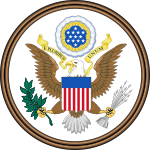미국-중화민국 관계
보이기

중화민국(타이완)과 미국은 1979년 이후로 비공식적인 관계를 유지해왔다. 2018년 3월 16일 미국 의회에 의해 타이완 여행법이 통과됨에 따라 미국과 타이완 간의 관계는 그 뒤로 높은 수준의 공식적인 관계로 조정되었다.[1]
미국과 청나라의 관계는 1844년 6월 16일 시작되었다. 타이완의 중화민국 정부과 미국 연방 정부 간의 관계는 베이징의 인식 때문에 공식적으로 종료되었다. 미국은 대만관계법과 함께 타이완 국민들과 관계를 가진다. 중화민국(ROC)에 대한 미국 외교부의 계획적 모호성 정책은 가능한 중화인민공화국(PRC)의 침입으로부터 중화민국(ROC)을 지원하고 양안관계를 안정화시키는데 중요한 반면 타이완에 대한 전략적 명확성 정책은 PRC의 반대를 이끌어낼 가능성이 있다.[2][3][4]
국가 비교
[편집]| 일반명 | 타이완 | 미국 |
|---|---|---|
| 공식 명칭 | 중화민국 | 미합중국 |
| 문장 | 
|

|
| 국기 | 
|

|
| 인구 | 23,519,518 (2016 추정)[5] | 324,403,593 (2016년 9월 추정)[6] |
| 인구 증가율 | 0.02% (2016 추정) | 0.77% (2014 추정)[7] |
| 도시화 | 총 인구 중 78.0% (2011) | 총 인구 중 82.4% (2012)[7] |
| 면적 | 36,193 km2 (해안 바다 영토 제외) | 9,525,468 km2 (해안 바다 영토 제외)[8] |
| 인구 밀도 | 649/km2 | 35/km2 |
| 수도 | 타이베이시 | 워싱턴 D.C. |
| 최대 도시 | 신베이시 – 3,972,204 (3,972,204 메트로) | 뉴욕 – 8,560,405 (20,182,305 메트로) |
| 정부 | 단일 이원집정부 공화제 | 연방 대통령 공화제 |
| 최초 지도자 | 쑨원 | 조지 워싱턴 |
| 현재 지도자 | 대통령: 차이잉원 부통령: 천젠런 |
대통령: 도널드 트럼프 부통령: 마이크 펜스 |
| 주 언어 | 타이완 만다린 (궈위) | 영어 |
| 주 종교 | 35.1% 불교, 33.0% 도교, 18.7% 무신론자, 3.9% 기독교, 3.5% 일관도 (XTD), 2.4% 기타, 2.2% en:Tiandism (XTD), 1.1% Miledadao (XTD), 0.8% en:Zailiism, 0.7% en:Xuanyuanism |
70.6% 기독교 (46.5% 개신교, 20.8% 가톨릭, 1.6% 몰몬교, 1.7% 기타 기독교), 22.8% 무교, 1.9% 유대교, 0.9% 이슬람교, 0.7% 불교, 0.7% 힌두교[9] |
| 민족 | 95% 한족, 70% Hokkien, 14% Hakka, 14% en:Waishengren | 77.1% 백인, 13.3% 아프리카계 미국인, 5.6% 아시아계 미국인, 2.6% 혼혈, 1.2% 미국의 원주민, 0.2% Native Hawaiian or Pacific Islander, With 17.6% Hispanic and Latino (of any race)[10] |
| GDP (명목) | $588.334 billion (2016 추산) | $18.558 trillion (2016 추산) |
| 일인당 GDP (명목) | $24,985 (2016 추산) | $57,220 (2016 추산) |
| GDP (PPP) | $1.147 trillion (2016 추산) | $18.558 trillion (2016 추산) |
| 일인당 GDP (PPP) | $48,703 (2016 추산) | $57,220 (2016 추산) |
| 실질 GDP 성장률 | 0.69% (2015) | 2.6% (2015) |
| 지니 계수 | 33.6 | 40.8 |
| HDI | 0.882 | 0.915 |
| 통화 | 신 대만 달러 (NT$) | 미국 달러 ($) |
| 군사 지출 | $10.9 billion | $640.0 billion |
| 병력 | 290,000 | 2,349,950 |
| 노동력 | 11,550,000 | 202,265,000 |
| 휴대 전화 | 28,610,000 | 327,577,529 |
타이완과 미국의 지도자 (1950년~ )

같이 보기
[편집]각주
[편집]- ↑ Steve, Chabot, (2018년 3월 16일). “H.R.535 - 115th Congress (2017-2018): Taiwan Travel Act”. 《www.congress.gov》 (영어). 2018년 4월 4일에 확인함.
- ↑ “Thesis” (PDF). 《repository.library.georgetown.edu》.
- ↑ “We're sorry, that page can't be found.” (PDF). 《fpc.state.gov》.
- ↑ Benson, Brett; Niou, Emerson (2000년 4월 7일). “Comprehending strategic ambiguity: US policy toward the Taiwan Strait security issue” – ResearchGate 경유.
- ↑ “Statistics from Statistical Bureau”. 《National Statistics, Republic of China (Taiwan)》. 2016년 9월 1일에 확인함.
- ↑ “Population Clock”. 《Census Bureau》. Census Bureau. 2016년 9월 4일에 확인함.
- ↑ 가 나 “The World Factbook”. 2020년 5월 21일에 원본 문서에서 보존된 문서. 2018년 4월 15일에 확인함.
- ↑ “Population by sex, annual rate of population increase, surface area and density” (PDF). United Nations Statistics Division.
- ↑ “America’s Changing Religious Landscape”. 《Pew Research Center》. Pew Research Center. 2016년 9월 4일에 확인함.
- ↑ “United States”. 《Census Bureau》. Census Bureau. 2016년 9월 4일에 확인함.
참고 자료
[편집]- Benson, Brett V., and Emerson MS Niou. "Public opinion, foreign policy, and the security balance in the Taiwan Strait." Security Studies 14.2 (2005): 274-289.
- Bush, Richard C. At cross purposes: US-Taiwan relations since 1942 (Routledge, 2015).
- Carpenter, Ted Galen. America's coming war with China: a collision course over Taiwan (Macmillan, 2015).
- Glaser, Charles L. "A US-China grand bargain? The hard choice between military competition and accommodation." International Security 39#4 (2015): 49-90.
- Hickey, Dennis Van Vranken. "America's Two-point Policy and the Future of Taiwan." Asian Survey (1988): 881-896. in JSTOR
- Hickey, Dennis V. "Parallel Progress: US-Taiwan Relations During an Era of Cross-Strait Rapprochement." Journal of Chinese Political Science 20#4 (2015): 369-384.
- Hu, Shaohua. "A Framework for Analysis of National Interest: United States Policy toward Taiwan," Contemporary Security Policy, Vol. 37, No. 1 (April 2016): 144-167.
- Liao, Nien-chung Chang, and Dalton Kuen-da Lin. "Rebalancing Taiwan–US Relations." Survival 57#6 (2015): 145-158. online
- Ling, Lily HM, Ching-Chane Hwang, and Boyu Chen. "Subaltern straits:‘exit’,‘voice’, and ‘loyalty’in the United States–China–Taiwan relations." International Relations of the Asia-Pacific (2009): lcp013.
- Peraino, Kevin. A Force So Swift: Mao, Truman, and the Birth of Modern China, 1949 (2017), focus on .S. policy in 1949
외부 링크
[편집]- Taiwan-US Relations Archived 2016년 3월 3일 - 웨이백 머신 from the Dean Peter Krogh Foreign Affairs Digital Archives Archived 2012년 1월 12일 - 웨이백 머신
- Mandatory Guidance from Department of State Regarding Contact with Taiwan
- U.S. Relations With Taiwan
- Taiwan - US Relations from the Dean Peter Krogh Foreign Affairs Digital Archives
- Stating America's Case to China's Hu Jintao: A Primer on U.S.-China-Taiwan Policy
